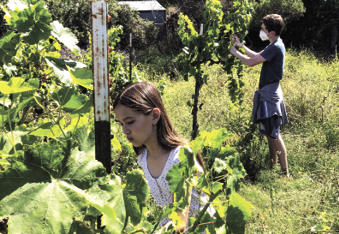Commentary: In the heart of the city, kids learn the love of farming


By Carrie Lawson Robertson
Strange as it sounds, I teach agriculture in the heart of Los Angeles. At the back of campus at our urban middle school, you’ll find a hidden gem we simply call “The Farm.”
These 2 acres house a traditional classroom, as well as a “land lab” that includes a vineyard, orchard, farm plots, raised beds, pollinator and native gardens, composting yard and tiny hiking trail.
Students help care for this and several goats, chickens, guinea pigs, rabbits, chinchillas and my favorite resident, Daisy, the pot belly pig. Our farm property backs up to Sunset Boulevard, a traffic-clogged artery that cuts across the city along the backbone of the Santa Monica Mountains. It’s a quintessential L.A. setting, complete with frequent Hollywood filming on campus.
We live amid a bastion of celebrity chefs, but growing the food yourself takes eating to a new level. It’s comical to watch students so gleeful over what they grew themselves: small plots of grapes, stone fruit, alfalfa, pumpkins, kale, tomatoes, artichokes and herbs. Our immersive agricultural experiences allow our “city kids” a chance to connect with the food they eat, understand the people who grow it and the natural world around them.
We are working to build a land ethic that reaches far beyond our classroom. Just like real ranchers and farmers, the students experience the pride and joy that comes from caring for animals, watching something grow, fixing things that break and working with their team to get the job done.
By far, the greatest teaching resource is my connection with the California Foundation for Ag in the Classroom. Judy Culbertson, the program’s executive director, and her tenacious staff provide a bounty of high-quality educational resources at no cost to teachers.
The highlight of my teaching year is attending the foundation’s conference, a jam-packed event featuring farmers panels, instructive workshops and farm tours. I’ve been able to bring those living stories back to the classroom—and my students— each year.
Thanks to the generous support of farmers and ranchers across the state who support the conference, students who live nowhere near a real farm get to see what modern production agriculture is really like. Farming is complex and high tech. It requires specific knowledge, hands-on experience and risk. Natural resources are vital to agriculture—and so are people.
I will jumpstart the first weeks of school using Ag in the Classroom resources, as my students explore the mystery and miracle that is…cotton candy grapes. Yum! The grapes—and any of our “food lab” activities—are a chance to make a connection. The grapes are just the road in. Ultimately, my goal is to create those “ah-ha” moments that bring agriculture into their daily lives.
I have always straddled two worlds—agriculture and urban life. My dad and grandad raised cattle on land they leased on the outskirts of Los Angeles. Driving down dusty roads, throwing out hay, viewing wildlife through binoculars and catching tadpoles in the creek are a constant thread through my childhood memories. And I was lucky to attend vibrant agriculture programs in middle and high school.
I’ve seen my former students go on to careers in agriculture and environmental fields: a forestry major at Montana State, a floral designer in Beverly Hills, a chef de cuisine at a Michelin-starred restaurant and a three-day-event equestrian competitor.
Agriculture-adjacent hobbies are the norm here, too. Hiking, gardening, indoor plants, pets and cooking became even more precious as we all spent more time at home and alone the past two years.
Here in Los Angeles, there are millions of people longing for a personal connection to food, land and agriculture. As urban residents, we often have a romanticized or inaccurate understanding of agriculture, but I believe this is a challenge that can be overcome with what we provide in the classroom.
Agriculture is not without challenges and discomfort, and I often worry how muddy shoes or a tired back will register with urban students. A few weeks ago, we spent a lot of time and sweat equity planting several young native trees in front of our classroom in very heavy, rocky soil. As we finished, one of my more challenging students stopped, turned and confronted me.
“Ms. R,” he said with a glare, “this was too hard! Why did we have to do this?”
Just as I was about to answer, he cut me off. He asked excitedly, “Can we do it again tomorrow?!”
Yes, we can.
(Carrie Lawson Robertson is an agriculture teacher, farm manager and FFA advisor at Paul Revere Charter Middle School and Magnet Center in Los Angeles. She may be contacted at carrie.robertson@lausd.net.)




